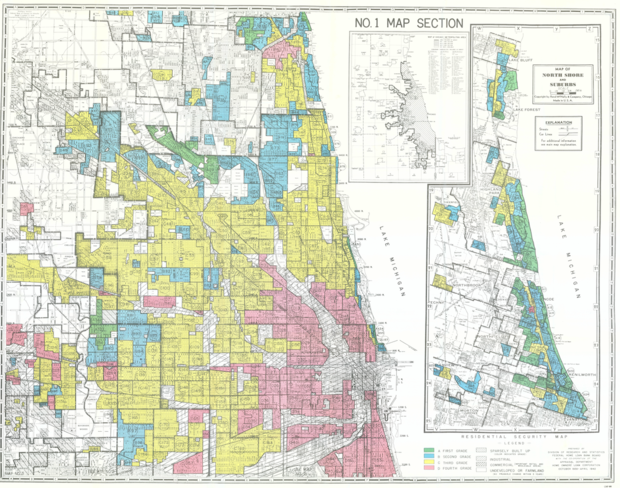Institutional racism is a form of racism that exists in the structures and institutions of our society. This is a form of racism that is heavily ingrained in our society to the point where it is difficult to see and even harder to fight. It creates inequalities in places such as wealth, environment, housing, education, healthcare, housing, employment, and the criminal justice system. This has been a tactic used against minority communities, specifically African Americans, for years and makes it harder for them to advance in society, the economy, and gain any form of wealth. Many people believed systemic racism disappeared with the Jim Crow Laws and the civil rights movement but there are many examples of today and from the past that show it hasn’t gone anywhere and it does not plan to.
In the 1900s banks would deny Black/Hispanic people mortgages, deny them loans, and prevent them from buying house in certain neighborhoods. They took maps of certain areas and marked them with red lines. The red marked areas were said to be risky to invest in and were to be denied mortgages and loans, while the green areas were more desirable and were more likely to be approved mortgages and loans. The red areas, of course, were predominately filled with Black/Hispanic people and enforced segregation, as it prevented them from moving into better neighborhoods and buying houses.

Redlining is seen as one of the biggest reasons for the racial wealth gap. It is said that Black families have lost out on at least $212,000 in personal wealth over the last 40 years because their home was redlined. This practice would also cause a slippery slope, as Black people could not move out of their poor neighborhoods nor gain any wealth to fix them, a vicious cycle of poverty was created. The redlined areas were isolated, had few employment opportunities, and its tax base shrunk which resulted in inadequate public services. Then as poverty in these areas increased it led to an increase in violence and crime rates which then led to an increase in policing and the arrests and murdering of Black people. The practice of redlining was banned in 1968 with the Fair Housing Act, but it still quietly persists today, just not with red lines on a map.
Another effect of systemic racism is environmental racism. While climate change is going to affect everyone, the people who will feel its effects first and be hit the hardest are poor people, and specifically racial minorities. The Black/Hispanic areas that were segregated and in poverty were also exposed to chemical substances such as lead paint, diesel fumes, crowding, litter, pesticides, and chemical plants. Racial minorities are more likely to live and work in America’s most polluted environments. They are also exposed to air pollution more. African Americans are exposed to 61% more of the tiny pollution particles that come from burning gasoline, Asian Americans 73% more, and Latinos 75% more than white Americans. Native Americans who live on reservations extremely poor, below the poverty line. Their homes are over crowded, have no running water, no electricity, and dirt roads that are dangerous to drive on (which is why car crashes is a leading cause of death for them). Many of them don’t even have mailboxes or addresses. Another example is the Dakota Access Pipeline. The pipeline was supposed to run through North Dakota to Illinois, but it also went through a sacred burial ground and the Missouri River which is the main drinking source for the Standing Rock Sioux Tribe’s reservation. Native American’s were worried that the pipe would leak and contaminate their drinking water as well as affect their sacred burial ground. Their requests to stop the pipeline were ignored and it was approved. Native activists are still fighting today to shut the pipeline down.
These are just a few examples of systemic, systemic racism goes deeper and worse. This is why it is important to correct people when they say our system is broken, because it’s not broken, it’s fully functioning as it was set up to do things like this.

Wow! I love how this covered lots of information. I appreciate how you ended with the fact that the system is functioning to be racist, not broken with racism as the unintended result. I personally believe that everyone grows up with racist views because society is inherently racist and passes these views onto people. However, we need to actively fight against racism, get educated, and educate others. Moreover, we have to fight against the false sense of security that our job is finished when a small goal is achieved. For example, many thought racism was over when President Obama got into office… Spoiler Alert: it isn’t and won’t be over anytime soon. Keep up the great work!
This was a very informative and interesting blog. You really cover a ton of information here. If you don’t experience this thing, it is hard to even know that they are happening without the education to learn about it. I would have never guessed that climate change will affect some people more than others, but that does make a lot of sense. I hope everyone can fight against these things and help make the world a better place for everyone. This was a great blog post thanks for sharing!